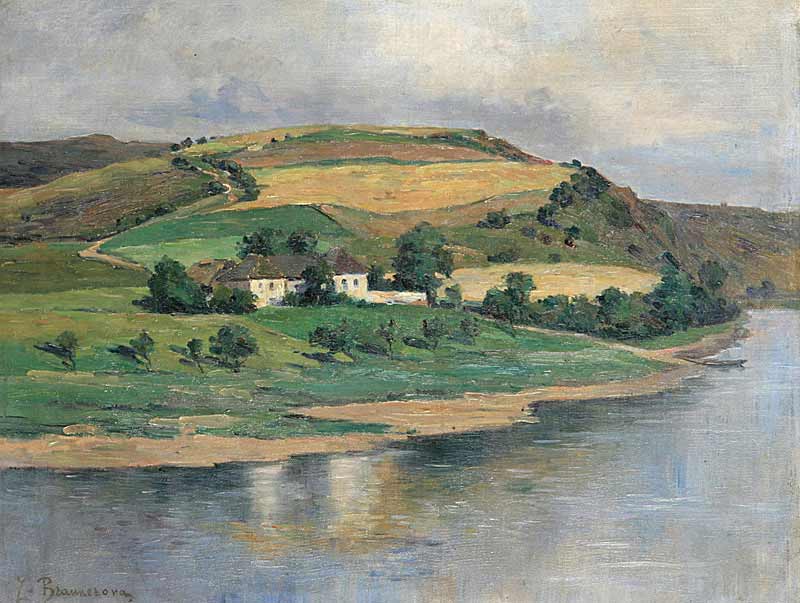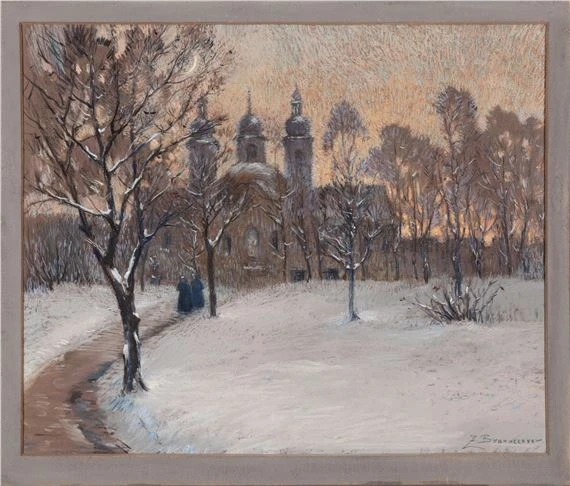In my blog today I am looking at the life and works of the nineteenth century Czech painter, Zdenka Rosalina Augusta Braunerová. Her views and lifestyle influenced many painters and writers, many of whom were her friends. She became a patron of many artists, but she also supported folk art, especially in Moravian Slovakia and Horňácko. She was graceful and educated, and also extremely talented. She decided to devote her whole life to painting and graphics and never regretted it. She almost married several times and yet died unmarried. The life of this girl from a good family was unconventional, but definitely interesting.

A Bend in the Vlatava River by Zdenka Braunerová
Zdenka was born in Prague on April 9th 1858 and was baptized as Zdislava Rosalina Augusta. She was born into a wealthy family and was the last of four children of the well-known Czech politician and prominent lawyer, František August Brauner and his wife Augusta, née Neumannová She had two older brothers, Vladamir and Bohuslav and an older sister, Anna. Zdenka showed interest in drawing and painting since her childhood, when she spent long hours in her children’s room, where she spent hours painting. She was encouraged to paint by her mother, who was herself an amateur painter and who came from an old noble family.

View at Brod by Amálie Mánesová,
Zdenka’s parents further encouraged their daughters interest in art and sent Zdenka to study with Amálie Mánesová, a talented landscape artist who ran a private painting school for ladies and girls from aristocratic and bourgeois families. This early art education, like the teaching of young children to play a musical instrument, was common for children in families of similar status at that time. It was part of the fashionable manner in which young girls became young ladies. Zdenka loved to paint and draw so much so that her normal schoolwork suffered and she received mediocre grades for her school work. Notwithstanding this deterioration of her exam results, Zdenka pressed on with her art tuition at a girls’ college, where the director was the prominent Czech painter, Soběslav Hipplolyt Pinkas.
One of her tutors was Antonin Chitussi, a Czech Impressionist landscape and cityscape painter, and he was unclear as to whether painting to Zdenka was merely a hobby and not a future profession and, in truth, Zdenka was also undecided as to whether painting or her singing would become a future pathway. Antonín Chittussi was not only one of her first art teachers, he was her first love and during her time with him she devoted herself mainly to landscape painting. Chittussi introduced her to the technical secrets of drawing and painting, urging her to diligence, study nature and the right choice of motifs. Zdenka wanted to move the relationship with Chittussi to another level, that of an equal union of two independent artists who would inspire each other. This was a step too far for Chittussi and the relationship died.
Following the the death of her father in 1880, Zdeňka began attending the Académie Colarossi in Paris. Here her teacher was Francoise Courtoise, with whom she concentrated mainly on figurative and historical painting.
Élémir Bourges and the two Brauner sisters – 1883
After her sister Anne’s marriage to the French writer Élémir Bourges, Zdenka adapted her lifestyle to her future profession as a painter. She often travelled between Paris and Prague, still attending the Colarossi School and at the same time wanting to be close to her mother back home in Prague.
Julius Zeyer
Another of her many relationships came three years later with a young poet, Julius Zeyer, an artist seventeen years her junior, but maybe because of the age difference, this was not a long-lasting liaison. Another reason according to some historians, was that Julius Zeyer was homosexual and his relationship with the very attractive Zdenka remained only platonic.
Vilém Mrštík
In the spring of 1894 in Oslavany, the thirty-one-year-old Czech playwright and literary critic Vilém Mrštík met thirty-six-year-old Zdenka Braunerová. She was five years older than him, which was somewhat strange as previously Vilém only had relationships with much younger women. Mrštík actually perceived her as an old lady describing her as:
“…An interesting person, she has enough of the world, enough of Prague, and with all the fire a lady approaching old virginity, but still strong and with the lush decoration of the former beauty…”
Brauner was equally scathing about Mrštík either, saying:
“….He is not pretty. The nose is plebeian, the eyes small, black, short-sighted with a stud, and the mouth with strong lips…”

Landscape near Tabor by Zdenka Braunerová.
Suprisingly, a relationship developed between them. It was not an even relationship as Zdenka was cautious at first and only considered friendship. But Mrštík, fell in love with Zdenka and the “friendship” developed into a love affair. The well-educated Brauner was probably attracted to Mrštík by his goodness, earthiness and often violent reactions. She tended to choose men who were painful, complex, and depressed. Zdenka had a habit of wanting to protect, educate and form men in her own way. She was manipulative and looked upon men as being people she could mould into her perfect person. This was not the basis of a long-lasting relationship and was doomed. However, she thought Mrštík would be different. Mrštík was not the intellectual type and unlike her, did not discuss art passionately. He was an earthy Moravian. To Zdenka, he even seemed naïve but this trait endeared him to her but the relationship was doomed.

St Lawrence on Petrin Hill by Zdenka Braunerova
In early 1896, Mrštík even began to talk about marriage and Zdenka agreed but they broke up in March 1897, just before the wedding, . They finally separated. Mrštík was convinced that he had fallen in love with an idea and not the woman. He became very bitter with the break-up and in an ungentlemanly way he said various unpleasant things about Zdenka – about her overripe old virginity and few talents in the intimate area. Zdenka, in turn, stated that his writing to be inferior. It was not an edifying ending to the affair

VEČERNÍ KRAJINA by Zdenka Braunerova
Although having attended the private Collarossi Academy, she was not satisfied with the tuition and returned to her homeland. Zdenka was still extremely interested and found inspiration in French art, but still retained the patriotism for her country. The more time she spent in Paris the more she missed her homeland. In Paris, with her sense of patriotism, she would dance in Czech costume and sang Czech national songs, and by doing so, she would move closer to the Czech culture and art. This love of her homeland inspired many French artists and helped forge lasting friendships there. One such artist who was swayed by Zdenka’s love of her homeland was Auguste Rodin who visited Bohemia and Moravia at her invitation in 1905.
Brauner’s Mill in Solutions
Zdenka often spent time working in a studio in Solutions, a small town, west of Prague. Her studio was in the so-called Brauner’s mill.
Zdenka Braunerová lived in Prague’s Lesser Town in Všehrdova Street. She died there on May 23rd 1934, aged 76, and is buried in the Vyšehrad cemetery.










:strip_icc()/BHG_PTSN19720-33d9cd22f6ab49e6a21982e451321898.jpg)

More Stories
Mapping Eastern Europe Website Launched
Kengo Kuma Designs a Dramatically Vaulted Cafe to Evoke Japan’s Sloping Tottori Sand Dunes — Colossal
Keeping The Artist Alive | Chris Locke | Episode 888